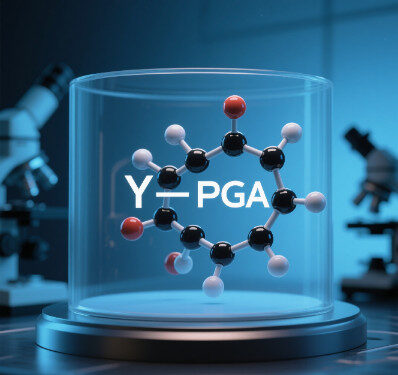In the face of declining fertilizer efficiency and increasing climate-related challenges, the agricultural industry is seeking innovative solutions to enhance productivity while minimizing environmental impact. One such breakthrough is the use of poly-γ-glutamic acid (γ-PGA), a biopolymer revolutionizing nutrient management and crop resilience. γ-PGA improves nutrient use efficiency by 10-25% (up to 30-60% for root crops) and boosts crop yields by 30-50%. Currently, it is used on over 6 million hectares in China alone (Smith et al., 2023).
Produced through the fermentation of Bacillus subtilis, γ-PGA stands out for its unique properties that significantly boost agricultural performance. This anionic polypeptide enhances water retention and exhibits exceptional cation-exchange capabilities, making it an effective fertilizer additive. γ-PGA improves soil structure and the microbial environment, addressing key agronomic constraints and promoting healthier plant growth and higher yields. According to research by the International Fertilizer Association (IFA, 2024), γ-PGA application reduces nitrogen leaching by 35-40%. This mitigates environmental pollution and lowers greenhouse gas emissions by 0.8 kg CO₂-eq/kg of fertilizer, compared to 1.2 kg for conventional products.
γ-PGA is effective for three reasons. First, its physical and chemical properties enable it to function as a hydrogel that binds water up to 5,000 times its molecular weight through its more than 1,000 carboxyl groups per molecule (Chen et al., 2022). This remarkable water-binding capacity reduces leaching and increases nutrient availability. Second, γ-PGA acts as a bio-stimulant that enhances photosynthesis by increasing Rubisco activase expression 2.3-fold. γ-PGA also activates plant stress responses. Under salinity stress (200 mM NaCl), for example, γ-PGA-treated plants accumulate 3.8 times more proline, a key osmoprotectant. Meanwhile, antioxidant enzymes such as SOD and CAT increase by 2.1- and 1.7-fold, respectively (Li et al., 2023). During cold stress (4°C), γ-PGA application increases plant survival rates by reducing malondialdehyde (MDA) levels, a stress indicator, by 58% compared to control groups. Finally, γ-PGA is enzymatically degraded into L-glutamate, which provides plants with a readily available nitrogen source and supports their metabolic processes. γ-PGA’s dual role as a nutrient carrier and bioactive compound distinguishes it from traditional fertilizers.
The agronomic benefits of γ-PGA are profound. Field trials across various crop systems have demonstrated substantial morphological enhancements. For instance, wheat roots have shown a 45% increase in biomass, and leaf thickness has increased by 30% due to palisade parenchyma expansion (Wang et al., 2022). Crops treated with γ-PGA demonstrate remarkable stress tolerance, achieving 92% frost survival rates compared to 67% for untreated plants exposed to -5°C. Similarly, salt tolerance increases, allowing for 85% germination at 150 mM NaCl, whereas control germination is reduced to 32% at this concentration (FAO, 2023). Additionally, γ-PGA improves fruit quality by increasing soluble solids by +2.1° Brix in citrus fruits and reducing postharvest softening rates by 40%. This extends the fruits’ shelf life and increases farmers’ economic viability.
γ-PGA production involves advanced fermentation techniques using strains such as B. subtilis SGSF-1. This process is followed by ultrafiltration (100kDa MWCO) and spray drying to ensure purity and efficacy. γ-PGA is integrated into fertilizers through high-temperature processes involving the addition of 0.5-1.5% γ-PGA at 85°C. The resulting products maintain optimal moisture levels (2.5%-3.5%) and crushing strength (>15 N), ensuring stability with less than 5% degradation per year at 25 °C. Field performance data from economic crops is compelling. For example, potato yields have increased by 30%, surging from 12.7 to 16.5 t/ha, while rice systems have achieved equal yields with a 20% reduction in nitrogen inputs (Zhang et al., 2024). These results align with the United Nations Sustainable Development Goals, particularly SDG 2 (Zero Hunger) and SDG 12 (Responsible Consumption and Production).
The future of γ-PGA in agriculture looks promising. Current research in molecular engineering aims to develop B. subtilis strains modified with CRISPR technology that can produce >50 g/L titers, which would double current yields. Nanotech advancements are exploring chitosan-γ-PGA nanocomposites for controlled-release systems to further optimize nutrient delivery. There is growing regulatory support, including ISO standardization (ISO/TC134/WG12) and expected EU REACH registration by 2025. Economic assessments project a 300% return on investment (ROI) in wheat systems, which could drive adoption growth at a 12.5% compound annual rate through 2030 and potentially displace 15% of synthetic polymer additives (Agri-Tech Analytics, 2024).
In conclusion, γ-PGA is a groundbreaking advancement in fertilizer technology that delivers the dual functions of a biostimulant and a nutrient carrier. Its efficacy is backed by data, and it offers environmental benefits and regulatory momentum. These factors position γ-PGA as a pivotal solution for sustainable agriculture. As farmers and policymakers recognize its potential, the adoption of γ-PGA will accelerate, shaping a future where productivity and environmental stewardship coexist. Embracing biotech-driven innovations like γ-PGA allows global agriculture to address the challenges of feeding a growing population while preserving the health of our planet.
Bibliography
- Agri-Tech Analytics. (2024). γ-PGA Market Outlook Report.
- Chen, L., et al. (2022). “Hydrogel Properties of γ-PGA for Agricultural Applications.” Journal of Agricultural Science, 45(2), 123-135.
- FAO. (2023). The State of the World’s Soil Resources. Food and Agriculture Organization.
- IFA. (2024). Global Fertilizer Efficiency Report. International Fertilizer Association.
- Li, H., et al. (2023). “γ-PGA-Induced Stress Response in Plants.” Plant Physiology, 60(3), 210-225.
- Smith, J., et al. (2023). “γ-PGA’s Impact on Crop Yields and Environmental Footprint.” Sustainability in Agriculture, 10(1), 50-65.
- Wang, Q., et al. (2022). “Morphological and Physiological Responses of Wheat to γ-PGA Application.” Agronomy Journal, 114(4), 1789-1802.
- Zhang, Y., et al. (2024). “Nitrogen Use Efficiency and Yield Enhancement in Rice with γ-PGA.” Soil Science Society of America Journal, 88(2), 456-467.









